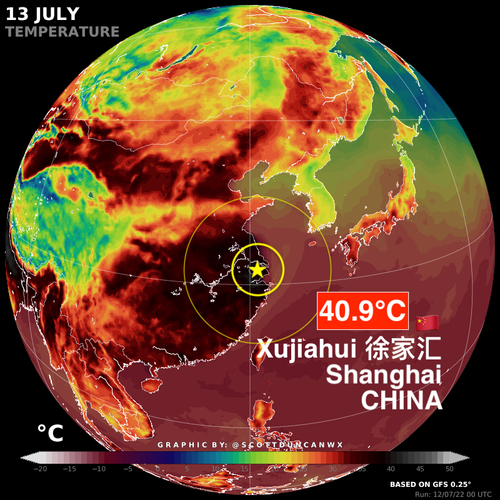
A massive heatwave has covered large swaths of China, including Shanghai, Southwest China's Sichuan Province, East China's Jiangsu, and Zhejiang provinces, affecting nearly one billion people.
At least 76 national weather stations recorded high temperatures that exceeded 108 degrees Fahrenheit on Wednesday, according to the National Climate Center. The highest temperature recorded was 111.5 degrees Fahrenheit in Lingshou, in North China's Hebei Province.
"The prolonged heatwaves have threatened crops and people's lives and pushed China's power usage to record-breaking levels. Despite the challenges, key industries in China have not experienced power cuts and the Chinese government has been taking measures, including drawing up off-peak power use plans, and helping farmers install more cooling machines," the state-owned mouthpiece Global Times.
However, South China Morning Post reports some factories in the Zhejiang Province have been asked to restrict power usage during peak demand hours to keep the power grid stable.
A zero-tolerance approach to COVID-19 in Chinese cities hammered the world's second-largest economy. And now, a dangerous heatwave has the potential to cause even more economic distress.
Prof Faith Chan of the University of Nottingham in the eastern Chinese city of Ningbo explained to The Guardian the extreme weather is no surprise and said, "the reason behind this year's heatwave is the two anticyclones, including the Western Pacific subtropical high from the sea and the one formed on the Persian Plateau which has moved to the Qinghai-Tibet Plateau."
Besides China, extreme weather, such as heatwaves and droughts, is present in the US, Europe, and India.
Some temporary relief could arrive in China's eastern and southern coastal regions by this weekend into early next week, Chen Tao, chief weather forecaster for the China Meteorological Administration, wrote on WeChat.
Is the world on fire?
All-time records tumbling in Europe as the heat gathers momentum in the south-west...
— Scott Duncan (@ScottDuncanWX) July 13, 2022
Incessant heat in China is also breaking very notable records with unbearably high dewpoints. pic.twitter.com/YG25lrtSyB
Coal-fired power accounts for roughly 60% of China's total electricity generation (2021 figures). We wonder if their grid is more reliable than the shaky grids of California and Texas that rely on an abundance of unreliable green technologies.
A massive heatwave has covered large swaths of China, including Shanghai, Southwest China’s Sichuan Province, East China’s Jiangsu, and Zhejiang provinces, affecting nearly one billion people.
At least 76 national weather stations recorded high temperatures that exceeded 108 degrees Fahrenheit on Wednesday, according to the National Climate Center. The highest temperature recorded was 111.5 degrees Fahrenheit in Lingshou, in North China’s Hebei Province.
“The prolonged heatwaves have threatened crops and people’s lives and pushed China’s power usage to record-breaking levels. Despite the challenges, key industries in China have not experienced power cuts and the Chinese government has been taking measures, including drawing up off-peak power use plans, and helping farmers install more cooling machines,” the state-owned mouthpiece Global Times.
However, South China Morning Post reports some factories in the Zhejiang Province have been asked to restrict power usage during peak demand hours to keep the power grid stable.
A zero-tolerance approach to COVID-19 in Chinese cities hammered the world’s second-largest economy. And now, a dangerous heatwave has the potential to cause even more economic distress.
Prof Faith Chan of the University of Nottingham in the eastern Chinese city of Ningbo explained to The Guardian the extreme weather is no surprise and said, “the reason behind this year’s heatwave is the two anticyclones, including the Western Pacific subtropical high from the sea and the one formed on the Persian Plateau which has moved to the Qinghai-Tibet Plateau.”
Besides China, extreme weather, such as heatwaves and droughts, is present in the US, Europe, and India.
Some temporary relief could arrive in China’s eastern and southern coastal regions by this weekend into early next week, Chen Tao, chief weather forecaster for the China Meteorological Administration, wrote on WeChat.
Is the world on fire?
All-time records tumbling in Europe as the heat gathers momentum in the south-west…
Incessant heat in China is also breaking very notable records with unbearably high dewpoints. pic.twitter.com/YG25lrtSyB
— Scott Duncan (@ScottDuncanWX) July 13, 2022
Coal-fired power accounts for roughly 60% of China’s total electricity generation (2021 figures). We wonder if their grid is more reliable than the shaky grids of California and Texas that rely on an abundance of unreliable green technologies.






